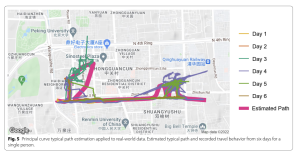 Richard Gonzalez
Richard Gonzalez
Center Director, Research Center for Group Dynamics, Institute for Social Research
Director, BioSocial Methods Collaborative, RCGD
Amos N Tversky Collegiate Professor, Psychology and Statistics, LSA
Professor of Marketing, Stephen M Ross School of Business
Professor of Integrative Systems and Design, College of Engineering
| E-mail: | Email Richard Gonzalez |
| Address: | Research Center for Group Dynamics Institute for Social Research University of Michigan 426 Thompson Street Ann Arbor, Michigan 48106 |
| Phone: | 734-647-6785 |
Estimating a typical path from GPS data
Nielsen, K., Mejía, S. & Gonzalez, R, (2022). Deviations from typical paths: A novel approach to working with GPS data in the behavioral sciences. International Journal of Health Geographics, 21, 1-16. doi:10.1186/s12942-022-00305-4 PDF
Abstract
Background: Behavioral science researchers are increasingly collecting detailed location data such as second-bysecond GPS tracking on participants due to increased ease and affordability. While intraindividual variability has been discussed in the travel literature for decades, traditional methods designed for studying individual differences in central tendencies limit the extent to which novel questions about variability in lived experiences can be answered. Thus, new methods of quantifying behavior that focus on intraindividual variability are needed to address the context in which the behavior occurs and the location tracking data from which behavior is derived.
Methods: We propose deviations from typical paths as a data processing technique to separate individual-level typical travel behavior from a location tracking data set in order to highlight atypical travel behavior as an outcome measure.
Results: A simulated data example shows how the method works to produce deviation measures from a location dataset. Analysis of these deviations offers additional insights compared to traditional measures of maximum daily distance from home.
Conclusions: This process can be integrated into larger research questions to explore predictors of atypical behavior and potential mechanisms of behavior change.



